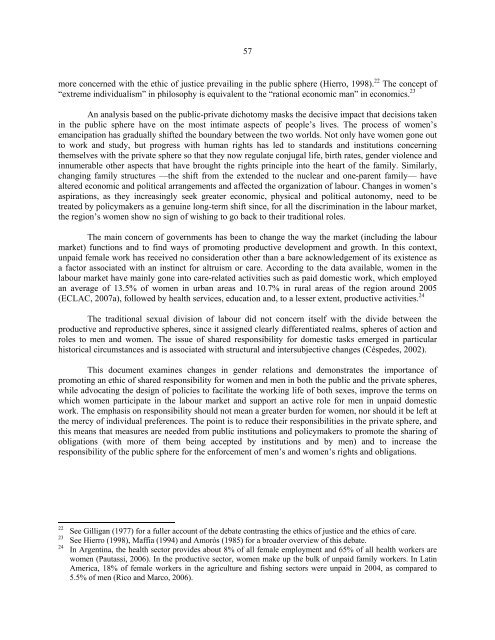Women in Latin America and the Caribbean - Cepal
Women in Latin America and the Caribbean - Cepal
Women in Latin America and the Caribbean - Cepal
Create successful ePaper yourself
Turn your PDF publications into a flip-book with our unique Google optimized e-Paper software.
57<br />
more concerned with <strong>the</strong> ethic of justice prevail<strong>in</strong>g <strong>in</strong> <strong>the</strong> public sphere (Hierro, 1998). 22 The concept of<br />
“extreme <strong>in</strong>dividualism” <strong>in</strong> philosophy is equivalent to <strong>the</strong> “rational economic man” <strong>in</strong> economics. 23<br />
An analysis based on <strong>the</strong> public-private dichotomy masks <strong>the</strong> decisive impact that decisions taken<br />
<strong>in</strong> <strong>the</strong> public sphere have on <strong>the</strong> most <strong>in</strong>timate aspects of people’s lives. The process of women’s<br />
emancipation has gradually shifted <strong>the</strong> boundary between <strong>the</strong> two worlds. Not only have women gone out<br />
to work <strong>and</strong> study, but progress with human rights has led to st<strong>and</strong>ards <strong>and</strong> <strong>in</strong>stitutions concern<strong>in</strong>g<br />
<strong>the</strong>mselves with <strong>the</strong> private sphere so that <strong>the</strong>y now regulate conjugal life, birth rates, gender violence <strong>and</strong><br />
<strong>in</strong>numerable o<strong>the</strong>r aspects that have brought <strong>the</strong> rights pr<strong>in</strong>ciple <strong>in</strong>to <strong>the</strong> heart of <strong>the</strong> family. Similarly,<br />
chang<strong>in</strong>g family structures —<strong>the</strong> shift from <strong>the</strong> extended to <strong>the</strong> nuclear <strong>and</strong> one-parent family— have<br />
altered economic <strong>and</strong> political arrangements <strong>and</strong> affected <strong>the</strong> organization of labour. Changes <strong>in</strong> women’s<br />
aspirations, as <strong>the</strong>y <strong>in</strong>creas<strong>in</strong>gly seek greater economic, physical <strong>and</strong> political autonomy, need to be<br />
treated by policymakers as a genu<strong>in</strong>e long-term shift s<strong>in</strong>ce, for all <strong>the</strong> discrim<strong>in</strong>ation <strong>in</strong> <strong>the</strong> labour market,<br />
<strong>the</strong> region’s women show no sign of wish<strong>in</strong>g to go back to <strong>the</strong>ir traditional roles.<br />
The ma<strong>in</strong> concern of governments has been to change <strong>the</strong> way <strong>the</strong> market (<strong>in</strong>clud<strong>in</strong>g <strong>the</strong> labour<br />
market) functions <strong>and</strong> to f<strong>in</strong>d ways of promot<strong>in</strong>g productive development <strong>and</strong> growth. In this context,<br />
unpaid female work has received no consideration o<strong>the</strong>r than a bare acknowledgement of its existence as<br />
a factor associated with an <strong>in</strong>st<strong>in</strong>ct for altruism or care. Accord<strong>in</strong>g to <strong>the</strong> data available, women <strong>in</strong> <strong>the</strong><br />
labour market have ma<strong>in</strong>ly gone <strong>in</strong>to care-related activities such as paid domestic work, which employed<br />
an average of 13.5% of women <strong>in</strong> urban areas <strong>and</strong> 10.7% <strong>in</strong> rural areas of <strong>the</strong> region around 2005<br />
(ECLAC, 2007a), followed by health services, education <strong>and</strong>, to a lesser extent, productive activities. 24<br />
The traditional sexual division of labour did not concern itself with <strong>the</strong> divide between <strong>the</strong><br />
productive <strong>and</strong> reproductive spheres, s<strong>in</strong>ce it assigned clearly differentiated realms, spheres of action <strong>and</strong><br />
roles to men <strong>and</strong> women. The issue of shared responsibility for domestic tasks emerged <strong>in</strong> particular<br />
historical circumstances <strong>and</strong> is associated with structural <strong>and</strong> <strong>in</strong>tersubjective changes (Céspedes, 2002).<br />
This document exam<strong>in</strong>es changes <strong>in</strong> gender relations <strong>and</strong> demonstrates <strong>the</strong> importance of<br />
promot<strong>in</strong>g an ethic of shared responsibility for women <strong>and</strong> men <strong>in</strong> both <strong>the</strong> public <strong>and</strong> <strong>the</strong> private spheres,<br />
while advocat<strong>in</strong>g <strong>the</strong> design of policies to facilitate <strong>the</strong> work<strong>in</strong>g life of both sexes, improve <strong>the</strong> terms on<br />
which women participate <strong>in</strong> <strong>the</strong> labour market <strong>and</strong> support an active role for men <strong>in</strong> unpaid domestic<br />
work. The emphasis on responsibility should not mean a greater burden for women, nor should it be left at<br />
<strong>the</strong> mercy of <strong>in</strong>dividual preferences. The po<strong>in</strong>t is to reduce <strong>the</strong>ir responsibilities <strong>in</strong> <strong>the</strong> private sphere, <strong>and</strong><br />
this means that measures are needed from public <strong>in</strong>stitutions <strong>and</strong> policymakers to promote <strong>the</strong> shar<strong>in</strong>g of<br />
obligations (with more of <strong>the</strong>m be<strong>in</strong>g accepted by <strong>in</strong>stitutions <strong>and</strong> by men) <strong>and</strong> to <strong>in</strong>crease <strong>the</strong><br />
responsibility of <strong>the</strong> public sphere for <strong>the</strong> enforcement of men’s <strong>and</strong> women’s rights <strong>and</strong> obligations.<br />
22<br />
23<br />
24<br />
See Gilligan (1977) for a fuller account of <strong>the</strong> debate contrast<strong>in</strong>g <strong>the</strong> ethics of justice <strong>and</strong> <strong>the</strong> ethics of care.<br />
See Hierro (1998), Maffia (1994) <strong>and</strong> Amorós (1985) for a broader overview of this debate.<br />
In Argent<strong>in</strong>a, <strong>the</strong> health sector provides about 8% of all female employment <strong>and</strong> 65% of all health workers are<br />
women (Pautassi, 2006). In <strong>the</strong> productive sector, women make up <strong>the</strong> bulk of unpaid family workers. In Lat<strong>in</strong><br />
<strong>America</strong>, 18% of female workers <strong>in</strong> <strong>the</strong> agriculture <strong>and</strong> fish<strong>in</strong>g sectors were unpaid <strong>in</strong> 2004, as compared to<br />
5.5% of men (Rico <strong>and</strong> Marco, 2006).











